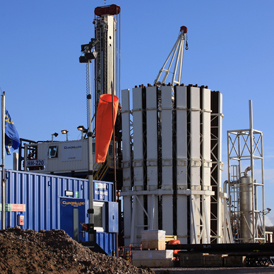Shale gas find in Lancashire fuels protests
A huge shale gas find underground in Lancashire could create 1,700 local jobs – but opponents fear it could undermine Britain’s burgeoning renewable energy industry.

Shale is a form of natural gas that is trapped in tiny cracks of rocks buried thousands of feet beneath the surface of the earth.
In July Cuadrilla Resources became the first in Europe to start drilling for the gas, which has already revolutionised the energy market in America.
Channel 4 News was given exclusive access at the time, and reported on this potential new energy source for Britain.
Now Cuadrilla Resources has announced there could be more than 200 trillion cubic feet of shale gas under Lancashire.
A percentage could be recovered for use in the UK’s energy mix, providing up to 5,600 jobs, including 1,700 in the local area, at the peak of production, the company has suggested.
In the US, where shale gas represents around 45 per cent of domestic supply, the energy source is becoming increasingly controversial.
A documentary called Gasland showed pollution incidents, allegedly caused by shale gas drilling, including tap water so contaminated with methane gas that it catches fire.
How to drill for Shale gas
Shale gas is locked in the matrix of less porous rocks and can only be accessed with a specialised technique, called ‘hydraulic fracturing’.
The gas companies drill downwards into the gas-bearing rock, as much as ten thousand feet below the surface. They then drill horizontally for thousands of feet more.
To "fracture" the shale, they pump in a mixture of water, chemicals and sand at very high pressure. The water opens up cracks in the rock, and the sand grains lodge in them and keep them open. This creates space for the gas to flow out of the rocks. It then travels back up the well bore, and is collected at the surface over the following months.
The process of extracting the gas, known as fracking, involves fracturing the ground to release the shale. Protesters gathered outside the news conference in Lancashire with “Frack off” banners.
Campaigners against the unconventional source of gas warn developing the fossil fuel could draw investment away from the UK’s potentially huge renewable industry.
Mark Miller, chief executive of Cuadrilla, said the process would not pose a threat to UK groundwater.
And he said the wells – as many as 400 over the next nine years and up to 800 over 16 years if gas extraction is successful – could be grouped in units of 10 on each football pitch-sized site, reducing their impact on the landscape.
Mr Miller said the company was “pleasantly surprised” by the findings of the exploration phase.
While the recoverable amount of gas would be only a proportion of the 200 trillion cubic feet underground, and it was too early to put a figure on the reserves, he predicted it would be a “significant” amount.
“We’re really happy with what we are finding,” he said.